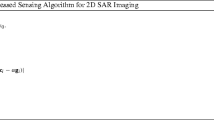Abstract
Spotlight synthetic aperture radar (SAR) emits a chirp signal and the echo bandwidth can be reduced through dechirp processing, where the A/D sampling rate decreases accordingly at the receiver. Compressive sensing allows the compressible signal to be reconstructed with a high probability using only a few samples by solving a linear program problem. This paper presents a novel signal sampling and imaging method for application to spotlight SAR based on compressive sensing. The signal is randomly sampled after dechirp processing to form a low-dimensional sample set, and the dechirp basis is imported to reconstruct the dechirp signal. Matching pursuit (MP) is used as a reconstruction algorithm. The reconstructed signal uses polar format algorithm (PFA) for imaging. Although our novel mechanism increases the system complexity to an extent, the data storage requirements can be compressed considerably. Several simulations verify the feasibility and accuracy of spotlight SAR signal processing via compressive sensing, and the method still obtains acceptable imaging results with 10% of the original echo data.
Similar content being viewed by others
References
Carrara W G, Goodman R S, Majewski R M. Spotlight Synthetic Aperture Radar: Signal Processing Algorithms. Boston: Artech House, 1995
Kashin B. The widths of certain finite dimensional sets and classes of smooth functions. Izv Akad Nauk SSSR Ser Mat, 1977, 41: 334–351
Baraniuk R, Steeghs P. Compressive radar imaging, In: IEEE Radar Conference, Boston, 2007. 128–133
Herman M A, Strohmer T. High-resolution radar via compressed sensing. IEEE Trans Signal Process, 2009, 57: 2275–2284
Tello Alonso M, Lopez-Dekker P, Mallorqui J J. A novel strategy for radar imaging based on compressive sensing. IEEE International Geoscience & Remote Sensing Symposium (IGARSS), Boston, 2008. 213–216
Ender J H G. On compressive sensing applied to radar. Signal Process, 2010, 90: 1402–1414
Caputi W J. Stretch: A time-transformation technique. IEEE Trans Aerosp Electron Syst, 1971, 7: 269–278
Wehner D R. High Resolution Radar. Norwood: Artech House, 1987
Giorgio F, Ricacardo L. Synthetic Aperture Radar Processing. Boca Raton: CRC Press, 1999
Donoho D. Compressed sensing. IEEE Trans Inf Theory, 2006, 52: 1289–1306
Candes E J. Compressive sampling. In: Proceedings of the International Congress of Mathematicians, Madrid, 2006. 1433–1452
Candes E J, Romberg J, Tao T. Robust uncertainty principles: Exact signal reconstruction from highly incomplete frequency information. IEEE Trans Inf Theory, 2006, 52: 489–509
Blumensath T, Davies M E. Gradient pursuits. IEEE Trans Signal Process, 2008, 56: 2370–2382
Davis G, Mallat S, Avellaneda M. Greedy adaptive approximation. J Constr Approx, 1997, 12: 57–98
Donoho D, Elad M, Temlyakov V. Stable recovery of sparse overcomplete representations in the presence of noise. IEEE Trans Inf Theory, 2006, 52: 6–18
Mallat S G, Zhang Z F. Matching pursuits with time-frequency dictionaries. IEEE Trans Signal Process, 1993, 41: 3397–3415
Tropp J A, Gilbert A C. Signal recovery from random measurement via orthogonal matching pursuit. IEEE Trans Inf Theory, 2007, 53: 4655–4666
Tropp J A, Wakin M B, Duarte M F, et al. Random filters for compressive sampling and reconstruction. In: IEEE International Conference on Acoustics, Speech, Signal Processing (ICASSP), Kyoto, 2006
Brookner E. Synthetic Aperture Radar Spotlight Mapper. Dedham: Artech House, 1977
Jakowatz C V, Wahl D E, Eichel P H, et al. Spotlight-Mode Synthetic Aperture Radar: A Signal Processing Approach. Boston: Kluwer Academic Publisher, 1996
Naftely N, Levy-Nathansohn R. Overview of the TECSAR satellite hardware and mosaic mode. IEEE Geosci Remote Sens Lett, 2008, 5: 423–426
Author information
Authors and Affiliations
Corresponding author
Rights and permissions
About this article
Cite this article
Xu, H., You, Y., Li, C. et al. Spotlight SAR sparse sampling and imaging method based on compressive sensing. Sci. China Inf. Sci. 55, 1816–1829 (2012). https://doi.org/10.1007/s11432-012-4630-7
Received:
Accepted:
Published:
Issue Date:
DOI: https://doi.org/10.1007/s11432-012-4630-7




